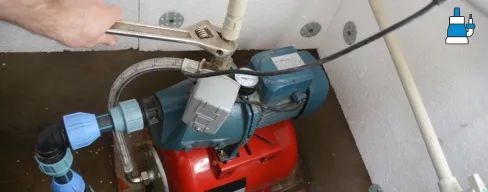Every construction needs good foundation drainage to be stable. Without effective drainage systems, water may gather around the foundation, causing serious issues that are sometimes overlooked until they are damaged. These flaws affect structural stability and may lead to expensive repairs that might have been avoided with preemptive actions.
Gutter, downspout, French drain, and move water away from the structure. French drains channel groundwater, while gutters drain pipe and downspouts carry precipitation away from the foundation.
This tutorial details how to secure your home with adequate drainage systems. Discover the significance of foundation drainage and how to install a foundation floor to collect water and minimize structural damage to save money. Understanding and using effective drainage solutions may prolong the life of your building and provide you peace of mind about water concerns.
House Foundation Drainage: Basics
What is Foundation Drainage?
Base drainage prevents water from accumulating around a building’s base. Water is diverted from the structure’s foundation using foundation drainage pipes, gravel, and waterproof coverings. The concrete or masonry foundation needs proper drainage to avoid cracking, mold development, and structural deterioration.
Water damage prevention is a major benefit of proper foundation drainage. Water surrounding a structure may seep into foundation cracks and joints, causing them to expand and contract with temperature.
This continual movement might cause foundation cracking and displacement. Water may also leak into basements or crawl spaces, producing moisture and mold development that harms the structure and its residents.
Assessing Your Home’s Foundation Drainage Needs
Identifying Signs of Poor Drainage
Finding symptoms of inadequate foundation drainage around the standing water in your basement or home might avert worse problems. Some key indications are:
- Water Pooling Indicators: Standing water in your yard or near the foundation after rain may suggest blocked foundation drain or inefficient soil absorption.
- Poor drainage may cause mold development and other issues in damp basements. This must be addressed immediately.
- If your house smells bad, it may be due to stagnant water and inadequate drainage. Odors attract insects and pests.
- Gutters and Downspouts: Debris accumulation or overflowing gutters during rainstorms may indicate obstructions that restrict water drainage.
- Soil Erosion: Soil erosion or exposed roots in your yard may indicate improper water runoff foundation drainage.
- Excess moisture from improper foundation drain may cause mold and mildew development on walls, floors, and ceilings.
- Plant Rot: Poor drainage may cause excess water to your plants and grass to struggle despite adequate maintenance. Soggy roots may decay.
Types of Foundation Drainage Systems
Surface Foundation Drain Systems
There are two types of foundation drainage. Surface drainage systems control water runoff and protect property. These systems depend on gutters and downspouts to direct roof rainfall away from the foundation. Rainwater is collected by gutters along the roof and directed to downspouts, vertical pipes that deliver it to ground level.
For optimum water management, landscape drainage grading is crucial. This entails creating a natural slope around the property to move surplus water away from the home and buildings and into drainage areas. These features work together to provide surface drainage, preserving the building and landscape.
Aluminum, vinyl, and copper are used for gutters and downspouts. Each material has pros and downsides, so consider longevity, upkeep, and aesthetics when picking one for your house or structure.
Subsurface Drainage Systems
Subsurface drainage systems constitute an indispensable component in the orchestration of water management surrounding both residential and commercial edifices. Comprising French drains, footing drains, and sump pumps connected to the sanitary well, and sanitary sewer system these systems collaboratively forestall water accumulation, thus preserving the integrity of structural foundations.
A French drain, essentially a trench replete with gravel or rock housing a perforated conduit, is engineered to reroute both surface runoff and groundwater away from a specified locale. By channeling excess water, French drains mitigate issues such as soil erosion and subterranean flooding, thus safeguarding buildings.
Footing drains, constructed at the foundation sewer near your floor’s basement floor base, are instrumental in water drainage management. Their principal function is to collect and redirect water away from the foundation, thereby fortifying the building’s structural soundness by averting potential moisture-induced damage. These drains are crucial in maintaining the dryness of basements and crawl spaces.
DIY vs. Professional Installation
Pros and Cons of DIY Projects
Consider the pros and downsides of DIY foundation draining. Cost reductions are a major benefit of DIY drainage projects. By removing labor, homeowners may cut project expenses dramatically. Doing the job oneself may sometimes be rewarding. DIY foundation drainage projects allow you to work at your own speed and make improvements.
But there are drawbacks. The knowledge and abilities needed are a huge downside. Poor installation might cause water damage or foundation instability without sufficient knowledge and competence. DIY projects need specific equipment and supplies and take time and effort.
Understanding when to DIY drainage systems is vital. DIYers may enjoy diverting downspouts or building French drains. However, for more difficult concerns like substantial excavation or water flow control for storm sewer, expert support is recommended to assure accuracy and efficiency.
When to Hire a Professional for Foundation Drainage
Foundation drainage is essential for building stability and long-term damage prevention. Knowing when to seek expert aid is crucial. Professional drainage solutions may be needed if you detect water collection around your foundation, odd wall cracking, or mold and mildew development.
Expert drainage services can assess the issue and give long-term remedies to protect your foundation. When to call a professional depends on the degree and persistence of the drainage difficulties. Minor issues may be fixed by DIY, but major or reoccurring issues need professional experience and accuracy.
Foundation drainage professionals can precisely detect the issue, which is a major advantage. DIY treatments may give temporary relief, but they seldom fix the core cause, causing future issues. Professional draining services have the tools and knowledge to check and analyze your foundation’s drainage system to discover concerns and provide the best solution.
Cost Considerations
Budgeting for Drainage Projects
Planning a foundation drainage project requires careful budgeting. Costs vary by system complexity and installation. Here are the main types:
French drains: French drains are popular because they use a gravel trench and a perforated pipe to divert water from the basement walls and foundation. The cost depends on drain length and location.
Sump Pump Systems: A pump in a basement or crawlspace removes water. Pump type and installation complexity affect costs.
Exterior Excavation Drainage Systems: Installing drainage pipes requires major foundation excavation. Installation requires manpower and equipment, raising the cost.
Interior Drain Tile Systems: These systems regulate water that enters basements by putting drain tiles around the whole foundation wall perimeter.
Long-term savings
Installing a solid foundation drainage system might save money over time. Water damage prevention saves homeowners a lot of money. Water entry may cause structural damage, mold development, and electrical system damage, which are costly to fix. Proper drainage systems help homes last longer and need fewer maintenance. When selling the house, effective drainage systems may boost its value.
Preventative Maintenance for Foundation Drainage
Regular Checkups
Drainage system performance and lifetime depend on regular inspections. At least twice a year, preferably in spring and fall, inspections should discover possible issues before they progress. Regular drainage maintenance prevents clogs, floods, and extends system life. Check for debris, tighten joints, and ensure water flows smoothly through the system.
Seasonal Maintenance Tips
Seasonal maintenance is essential for drainage system function. Clear winter garbage and leaves in spring. This will help avoid rainy season bottlenecks. Check for temperature-induced cracks and damage in summer. Fall leaves and organic stuff may clog the system, so remove them often. Ensuring all drainage system components operate properly helps avoid freezing damage.
Chronic Care Plans
Consider a drainage maintenance plan for long-term care. This strategy should include regular drainage inspections, seasonal maintenance, and rapid problem remedies. Gutter guards reduce debris accumulation, and high-quality repairs and installs increase system life. To keep your system running well, stay up to date on inspection techniques and drainage technologies.
Conclusion
Drainage systems need regular maintenance and inspections to work properly. Understanding drainage costs and long-term advantages can help you make educated selections for your house, whether you do it yourself or hire professionals.
A good drainage system protects and increases the value of your house. With proper planning and care, you can maintain a dry, strong foundation for years. See the related resources and contact information for further information. Start protecting your property from water damage now and enjoy the assurance of a stable foundation.
By choosing Drain Express, you can be sure of the quality of the installation of the drainage of the two foundation walls of your house. Our experience and feedback from our customers guarantee the effectiveness of our work. The specialists of our company are always ready to help you and guide you all the way: from consultation to installation and maintenance.
Contact Details
Email: info@drainexpress.ca
Phone:
+1 647 247 0846
Our Location
300 New Toronto St #14,
Etobicoke, ON, M8V 2E8
24/h Customer Service
We are open 24/7
Contact us at any time

